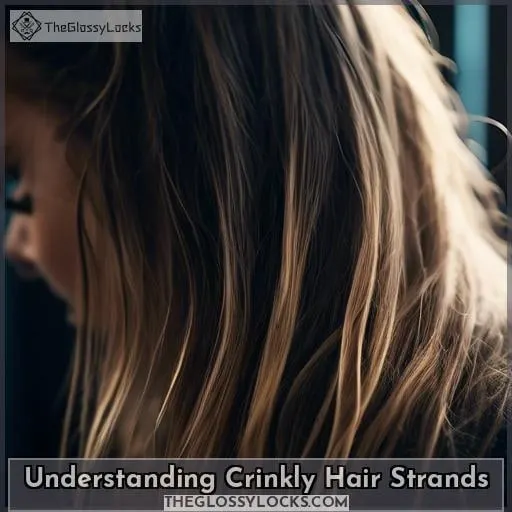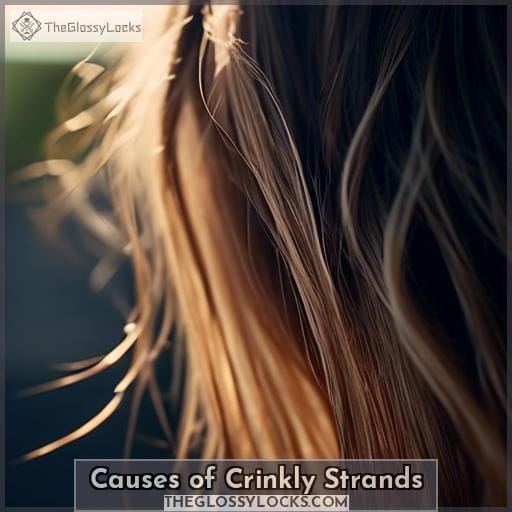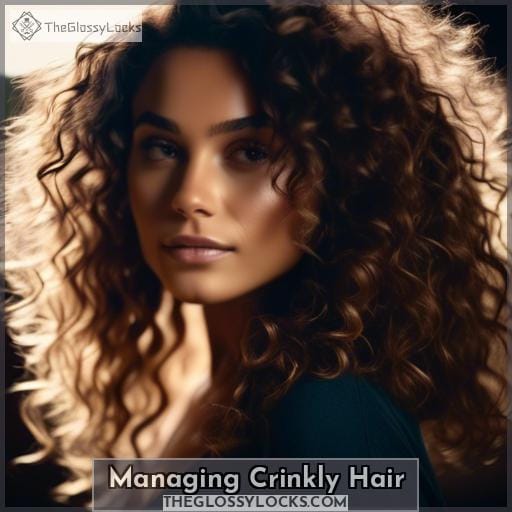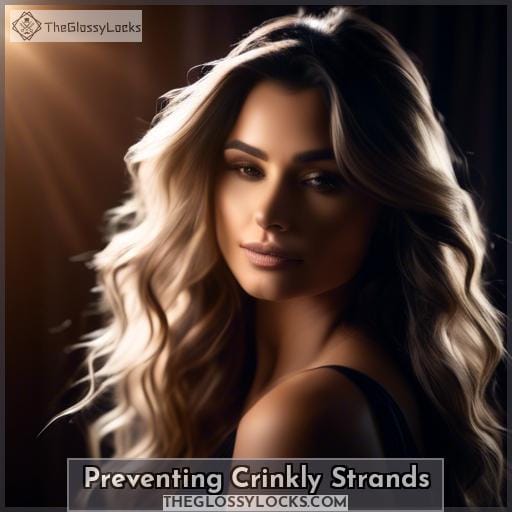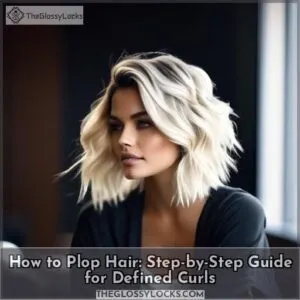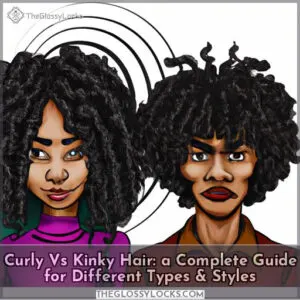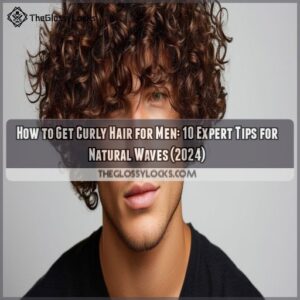This site is supported by our readers. We may earn a commission, at no cost to you, if you purchase through links.
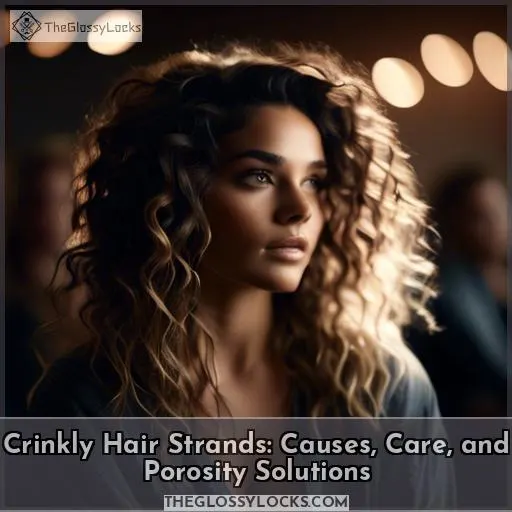 Like a river’s journey shapes its banks, your environment, habits, and genetics sculpt the texture of your hair.
Like a river’s journey shapes its banks, your environment, habits, and genetics sculpt the texture of your hair.
If you’ve encountered crinkly hair strands, you’re not alone. These twists and bends in your locks can be a sign of damage or a natural aspect of your hair’s character.
Understanding the causes and learning how to manage and prevent them can lead to a harmonious relationship with your tresses.
Let’s explore the intricacies of crinkly hair and unveil the secrets to nurturing your unique strands.
Table Of Contents
- Key Takeaways
- Understanding Crinkly Hair Strands
- Causes of Crinkly Strands
- Managing Crinkly Hair
- Preventing Crinkly Strands
- Understanding Hair Porosity
- Frequently Asked Questions (FAQs)
- How does the water quality in different geographical locations affect the structure and health of hair strands?
- Can dietary changes or specific nutrient deficiencies lead to the development of crinkly hair strands?
- What role do hormonal fluctuations play in altering the texture and appearance of hair, potentially causing crinkliness?
- How does the aging process impact hair texture, and can it contribute to the formation of crinkly strands over time?
- Are there any specific hair care practices or products that can inadvertently cause hair strands to become crinkly, outside of heat and chemical treatments?
- Conclusion
Key Takeaways
- Crinkly hair can be caused by a variety of factors, including heat styling, chemical treatments, and environmental damage such as water quality and pollution.
- Genetics play a significant role in determining hair texture, with certain genes influencing the structure of keratin proteins within the hair shaft, leading to naturally curly or coily hair that may appear crinkly.
- Proper hair care is crucial for managing crinkly hair, including regular trimming, using protein treatments, and avoiding heat and harsh chemicals to maintain hair health and prevent further damage.
- Preventative measures such as protective hairstyles, minimizing heat styling, and understanding hair porosity can help in reducing the occurrence of crinkly strands and maintaining overall hair health.
Understanding Crinkly Hair Strands
Have you noticed some of your hair strands feeling crinkly and different from the rest?
This phenomenon isn’t just about your hair’s natural texture or a bad hair day; it’s deeply rooted in the structure of your hair strands, including the medulla, cortex, and cuticle, and influenced by genetics and environmental factors like humidity.
Understanding these aspects can help you navigate through the causes and find effective care and porosity solutions to manage crinkly hair strands effectively.
Hair Strand Structure
Understanding the structure of your hair is crucial in addressing crinkly strands and ensuring overall hair health.
Your hair grows from a follicle, a tiny pocket in the skin, and its shape influences whether your hair is straight, wavy, or curly.
The hair shaft, the part you see and style, comprises three layers: the cuticle, cortex, and sometimes the medulla. The cuticle is the outermost layer, acting as a protective shield for the more delicate inner layers.
It’s made of overlapping cells that, when healthy, lie flat, giving your hair a smooth, shiny appearance.
Damage to the cuticle, through heat styling, chemical treatments, or environmental factors, can lift these scales, leading to dry, brittle, and crinkly hair. The cortex, which makes up the bulk of the hair strand, contains the pigment that gives your hair its color.
Maintaining cuticle health is essential for preventing moisture loss and protecting the cortex, ensuring your hair remains strong, flexible, and resilient against crinkly strands.
Role of Genetics and Natural Texture
Your natural texture and the health of your hair are deeply rooted in your genetics.
- Genetic Blueprint: Your genes determine the natural texture of your hair, whether it’s straight, wavy, or curly. The shape of your hair follicles, influenced by your genetic makeup, dictates this texture.
- Hair Growth Patterns: The angle at which your hair grows out of the follicle is also genetically programmed, which can affect whether your hair strands are prone to crinkling.
- Genetic Disorders: Certain genetic disorders, like Menkes disease and Occipital Horn Syndrome, which are related to mutations in the ATP7A gene, can lead to changes in hair texture, such as kinky hair.
Environmental factors, dry or damaged hair, and even the way you care for your hair can influence its texture, but your genetic code lays the foundation for your hair’s natural state.
Impact of Environmental Factors
Environmental factors like climate change and geographic location can wreak havoc on your hair. London’s dampness may turn your sleek strands crinkly, while hard water affects hair’s integrity.
| Factor | Impact on Hair |
|---|---|
| Climate Change | Alters texture |
| Geographic Location | Influences hair behavior |
| Water Quality | Affects hair health |
| Pollution | Leads to damage |
Causes of Crinkly Strands
You might notice some strands of your hair standing out, feeling rough, and disrupting your overall hair texture. These crinkly strands can be a sign of damage, often caused by heat styling, chemical treatments, or even the friction from hair accessories.
To address these issues, it’s essential to understand the underlying causes and implement appropriate hair care practices to restore your hair’s health.
Damage From Heat and Chemicals
Heat and chemical treatments can significantly impact your hair’s health, leading to crinkly strands and increased porosity. When you apply heat or undergo chemical processes, you’re essentially altering the hair’s structure.
Heat treatments, such as blow-drying, straightening, and curling, can cause the hair’s cuticle layer to lift and separate, leading to dryness, brittleness, and a loss of natural moisture. Chemical treatments, including dyes, relaxers, and perms, break down the hair’s disulfide bonds, changing its texture but also making it more susceptible to damage.
These processes can increase your hair’s porosity, which means its ability to absorb and retain moisture is compromised. High porosity hair absorbs moisture quickly but loses it just as fast, making it prone to dryness and breakage.
Light-colored or bleached hair is particularly vulnerable because the process of lightening hair involves breaking down its natural pigment, further weakening the hair’s structure.
To mitigate the effects of heat and chemical damage, it’s crucial to adopt protective measures. Using heat protectants can create a barrier between your hair and styling tools, reducing the risk of damage.
Regular hair trimming helps remove split ends and prevents further splitting up the hair shaft. Incorporating protein treatments and henna can also help repair and strengthen damaged strands. Additionally, switching to porosity control shampoos can help manage your hair’s moisture levels, making it more resilient against damage.
In summary, while heat and chemical treatments can offer the desired aesthetic changes, they come with the risk of damaging your hair. Understanding these risks and taking steps to protect and repair your hair can help maintain its health and appearance despite these treatments.
Effects of Hair Accessories and Friction
Friction damage, hair breakage, and styling damage are common issues caused by hair accessories and friction.
- Choose hair ties and headbands made of soft materials like silk or satin to minimize friction damage and prevent hair breakage.
- Avoid metal barrettes and tight elastic bands that can cause styling damage and instead opt for snag-free options.
- Implement protective hairstyles that reduce the stress on your hair from accessories and daily wear.
Porosity and Moisture Issues
Porosity plays a crucial role in hair health, affecting moisture absorption and retention. Damage from heat or chemicals can increase porosity, leading to crinkly strands. Issues like calcium deposits or nervous system problems can impact hair porosity.
Understanding porosity levels is key to addressing crinkly hair. Adjusting hair care routines based on porosity can help maintain healthy, moisturized strands.
| Porosity Levels | Impact on Hair | Recommended Care |
|---|---|---|
| Low | Less vulnerable to damage | Regular conditioning |
| Medium | Moderate moisture retention | Protein treatments |
| High | Prone to damage and dryness | Porosity control shampoo |
Managing Crinkly Hair
Managing crinkly hair strands requires a blend of targeted care and preventive measures.
Regular trimming is essential to remove split ends and prevent further damage, ensuring your hair remains healthy and strong.
Incorporating protein treatments and henna can help repair and strengthen your hair.
Choosing the right shampoo for porosity control can significantly improve moisture retention and overall hair texture.
Importance of Regular Trimming
Continuing from the discussion on the causes of crinkly strands, it’s crucial to address the importance of regular trimming in managing these issues.
Trimming frequency is key to maintaining hair health; it’s recommended to trim every 6-8 weeks to prevent split ends from traveling up the hair shaft, which can exacerbate crinkles. Trimming effectiveness lies in its ability to remove damaged ends, improving the overall appearance and texture of your hair.
When it comes to trimming techniques, ensure you’re using sharp, professional trimming tools to achieve a clean cut without causing additional damage. Developing good trimming habits, such as seeking a professional stylist and avoiding DIY cuts, can significantly contribute to the health of your hair.
Regular trims can also enhance hair conditioning efforts, making your mane more manageable and less prone to tangling, regardless of whether you’re dealing with white hair or any other color.
Benefits of Protein and Henna Treatments
Protein treatments can be a game-changer for your crinkly strands, offering a host of benefits. They work by replenishing proteins lost from the hair, strengthening it, and reducing the likelihood of hair loss.
These treatments also enhance hair’s elasticity, making it less prone to snapping and more responsive to styling.
Henna, on the other hand, is a natural remedy with antifungal properties, which can be particularly beneficial for those dealing with dandruff or hair-fall issues. It also helps in reducing premature graying and adds a softening effect due to its vitamin E content.
When considering Protein vs. Henna, it’s important to note that while protein treatments focus on repairing and strengthening hair, henna provides a natural dyeing effect along with its conditioning benefits.
However, henna can be drying, so it’s crucial to balance it with moisturizing ingredients.
Choosing the Right Shampoo for Porosity Control
After exploring protein and henna treatments, let’s dive into shampoo selection for porosity control.
If your hair’s moisture retention isn’t up to par, it’s time to rethink your hair care routine. Opt for a shampoo specifically designed for porosity issues, which gently cleanses without stripping natural oils and targets conditioning where it’s needed most.
Preventing Crinkly Strands
To fend off crinkly hair strands, it’s essential to minimize the use of heat styling tools and harsh chemical treatments that can damage hair.
You’ll want to adopt protective hairstyles that shield your hair from potential harm, ensuring it remains healthy and resilient.
Consistent and proper hair care, including the use of suitable products and regular trims, plays a pivotal role in preventing the emergence of crinkly strands.
Avoiding Heat and Chemical Treatments
To seamlessly transition from managing crinkly strands to preventing them, it’s crucial to focus on avoiding heat and chemical treatments. These practices can exacerbate hair damage, leading to more pronounced crinkles and porosity issues.
Instead, embrace protective hairstyles that minimize friction damage and reduce the need for frequent styling. By prioritizing the health of your hair over temporary styling gains, you’ll not only preserve its natural texture but also prevent further damage.
This approach is essential for maintaining vibrant, healthy hair that’s free from the adverse effects of excessive heat and harsh chemicals.
Protective Hairstyles to Reduce Damage
Protective hairstyles can be a game-changer for maintaining hair health and preventing damage. These styles keep your hair secure and minimize exposure to environmental stressors that can lead to crinkles.
When you choose a protective style, you’re not just keeping your hair tidy; you’re actively reducing the friction that can disrupt your hair’s integrity. Think of protective styling as a shield against the daily wear and tear that can lead to those pesky crinkly strands.
Whether you opt for braids, twists, or updos, ensuring your hair is neatly tucked away can help maintain its natural texture and prevent further damage. Remember, the goal is to keep your hair’s movement to a minimum, which in turn reduces the chances of friction and tangling.
So, when you’re planning your hair care routine, don’t overlook the power of a good protective style to keep your locks looking their best.
Maintaining Hair Health With Proper Care
Transitioning from protective hairstyles, maintaining hair health requires a dedicated routine.
- Regularly condition to keep strands hydrated.
- Minimize heat styling to prevent damage.
- Use hair products tailored to your specific needs.
- Explore natural remedies, like oils and masks, to nourish and strengthen.
By integrating these steps, you’ll protect your hair’s integrity and prevent crinkly strands, ensuring it stays healthy and vibrant.
Understanding Hair Porosity
Understanding your hair’s porosity is crucial for managing crinkly strands effectively. By conducting simple porosity tests, you can learn how your hair absorbs and retains moisture, which directly impacts its health and appearance.
Adjusting your hair care routine based on your porosity level—whether it’s incorporating protein treatments for high porosity hair or using porosity control shampoos—can significantly improve your hair’s texture and resilience.
Conducting Porosity Tests
To seamlessly transition from preventing crinkly strands to understanding your hair’s porosity, it’s crucial to conduct porosity tests. These tests reveal your hair’s ability to absorb and retain moisture, which is vital for maintaining its health and texture.
Start with the float test; clean a strand of your hair and drop it into a glass of water. If it floats, you likely have low porosity hair, which struggles to absorb moisture. If it sinks, high porosity is indicated, meaning your hair absorbs moisture quickly but doesn’t retain it well.
For a more tactile approach, try the slide test. Run your fingers up a strand towards the scalp; a smooth feeling suggests low porosity, while a bumpy texture indicates high porosity.
Understanding your porosity levels can guide you to tailor your hair care routine, ensuring your hair’s needs for moisture absorption and retention are met, ultimately influencing your hair growth and the angle at which it grows.
Factors Increasing Porosity
As you’ve learned about hair porosity, it’s crucial to recognize the factors that can increase it. Water quality, particularly hard water, can leave mineral deposits on your hair, making it more porous.
Environmental factors like sun exposure and pollution can also degrade the hair cuticle, leading to increased porosity. Stress hormones can influence your hair’s health, potentially affecting its porosity.
Underlying conditions, such as nutritional deficiencies, may also play a role. To maintain your hair’s integrity and support healthy hair growth, it’s important to be mindful of these factors and adjust your hair care routine accordingly.
Adjusting Hair Care for Porosity Levels
Adjusting your hair care routine to match your hair’s porosity levels can significantly improve its health and appearance.
- Identify Your Hair’s Porosity: Use the float or slide test to understand if your hair has low, normal, or high porosity. This will guide your product selection and care practices.
- Choose the Right Products: Select shampoos, conditioners, and styling products that are formulated for your hair’s porosity. High porosity hair benefits from protein treatments and heavy moisturizers, while low porosity hair needs lighter, hydrating products.
- Adjust Your Washing Routine: High porosity hair may require more frequent conditioning and less shampooing to maintain moisture retention, whereas low porosity hair might need clarifying shampoos to prevent build-up.
- Style with Care: Avoid heat styling and harsh chemicals if your hair is highly porous. For low porosity hair, use heat (moderately) to help open up the cuticle for better moisture absorption.
By understanding and managing your hair’s porosity, you can enhance hair elasticity, improve moisture retention, and tailor your hair care routine for healthier, more resilient strands.
Frequently Asked Questions (FAQs)
How does the water quality in different geographical locations affect the structure and health of hair strands?
Water quality varies globally, affecting hair’s structure and health.
Hard water, rich in minerals like calcium and magnesium, can weaken hair, making it prone to breakage and damage.
Conversely, soft water can enhance hair’s manageability and health. It allows better hydration and product efficacy.
Can dietary changes or specific nutrient deficiencies lead to the development of crinkly hair strands?
Yes, dietary changes or specific nutrient deficiencies can indeed lead to crinkly hair strands. Your hair needs essential vitamins and minerals to maintain its health and structure.
What role do hormonal fluctuations play in altering the texture and appearance of hair, potentially causing crinkliness?
Hormonal fluctuations can be like a rollercoaster for your hair, impacting its texture and fullness.
They can turn your sleek strands into a frizzy affair, potentially leading to that crinkliness you’re noticing.
How does the aging process impact hair texture, and can it contribute to the formation of crinkly strands over time?
As you age, your hair’s texture can change. This change may involve becoming thinner, less pigmented, and more prone to crinkles. These alterations are often attributed to reduced melanin and follicle activity.
Are there any specific hair care practices or products that can inadvertently cause hair strands to become crinkly, outside of heat and chemical treatments?
Yes, certain hair care practices and products can inadvertently cause hair strands to become crinkly, even aside from heat and chemical treatments.
Over-washing your hair can strip it of natural oils, leading to dryness and crinkliness. Using the wrong hair products, especially those containing harsh chemicals like sulfates and parabens, can also damage your hair’s natural structure and moisture balance, resulting in crinkly strands.
Not detangling properly after washing can cause mechanical damage, making some strands crinkly. Additionally, excessive shampooing can remove essential oils, leaving hair dry and prone to crinkliness.
To avoid these issues, it’s crucial to choose products suited to your hair type, limit shampooing, and detangle gently.
Conclusion
As the saying goes, a stitch in time saves nine, and the same can be applied to managing crinkly hair strands.
By understanding the root causes, from genetic predispositions to environmental impacts, you’re already on the path to healthier hair.
Regular trims, along with protein and henna treatments, will keep your locks strong and resilient.
Don’t forget the importance of choosing the right shampoo to manage porosity and maintain moisture balance.
By embracing your hair’s natural texture and adjusting your care routine to its unique needs, you’ll find that managing crinkly hair isn’t just about battling issues but celebrating and nurturing your hair’s inherent beauty.

